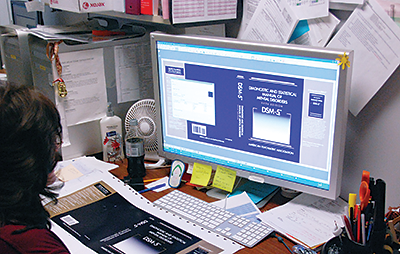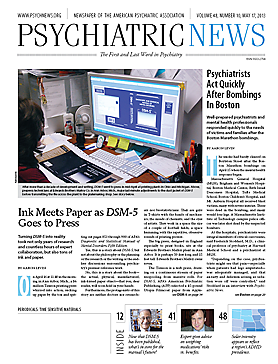On April 16 at 11:40 in the morning in Ann Arbor, Mich., a $6 million Timson printing press whirred into action, sucking up paper by the ton and spitting out pages 853 through 900 of APA’s Diagnostic and Statistical Manual of Mental Disorders, Fifth Edition.
Yes, this is a story about DSM-5, but not about the philosophy or the planning or the research or the writing or the endless discussions surrounding psychiatry’s premier reference work.
No, this is a story about the book—the actual, physical, manufactured, ink-kissed paper object—that you, dear reader, will soon hold in your hands.
Furthermore, the protagonists of this story are neither doctors nor researchers nor biostatisticians. They are guys in T-shirts with the hands of mechanics, the minds of chemists, and the eyes of artists. They work in a space the size of a couple of football fields, a space humming with the repetitive, obsessive sounds of printing presses.
The big press, designed in England especially to print books, sits at the Edwards Brothers Malloy plant in Ann Arbor. It is perhaps 50 feet long and 15 feet tall. Edwards Brothers Malloy owns seven.
The Timson is a web press, drawing on a continuous stream of paper unspooling from massive rolls. For DSM-5, APA’s American Psychiatric Publishing (APP) selected a 45-pound Utopia Filmcoat paper from Appleton Coated, in Combined Locks, Wis. Edwards Brothers Malloy’s purchasing manager, Sheila Whittenton, ordered 11-and-a-half truckloads from the mill. The paper arrived in four-foot-diameter rolls, each weighing about 3,100 pounds. Whittenton also called for 5,000 pounds of ink from the Flint Ink Company.
The coated paper keeps more of the ink on its surface rather than absorbing it, so letters remain crisper and more readable. The paper is strong but thin—750 pages to the inch—producing a 992-page book with less overall thickness and weight than a heavier sheet.
A computerized system takes the specifications—the number of pages and printing plates, the presses used, the binding process—calculates the number of hours for each step, and then coordinates their movement through the plant.
This job is not technically unusual for the printers but, says Whittenton, “there are a lot of copies.”
In fact, the press run is so large that APP has split the job between Edwards Brothers Malloy and R.R. Donnelley’s plant in Willard, Ohio. (Donnelley printed all prior editions of DSM.) Each company will print 75,000 copies of the softcover book and 15,500 copies of the hardcover version. Edwards Brothers Malloy will also print 50,000 copies of the DSM-5 Desk Reference. And that’s just for a start. Orders for additional printings will go out as needed.
Out on the pressroom floor, Jeremy Klann, an assistant press operator, slides a ton and a half of paper into place using rollers built into the floor. He slices through the brown kraft paper covering the roll and then through some of the white printing paper below.
“Sometimes in transport, the paper gets damaged, so we have to take about 20 to 30 layers of paper off to get to virgin stock,” he says. “Then when it gets spliced into a new roll, it won’t rip at a weak spot.”
Klann hoists the fresh roll into place with an electric lift. He trims off the end and attaches a blue adhesive strip across the trailing end of the paper. An electric eye reads the dwindling feed roll. When it gets close to the end, the press automatically slices off the old roll and slaps the edge into contact with the adhesive on the new roll. The paper goes over a series of rollers, collectively called a “festoon,” a reservoir of paper that equalizes pressure while the new roll gets up to speed. Without a pause, fresh paper feeds the press’s unending hunger.
The paper snakes through the press in a blur. Like nearly all working presses today, the Timson is an offset press. Giant aluminum printing plates are curved around rollers. Each plate holds two copies of a set of 24 pages of DSM-5 (they’ll be sliced apart after printing).
On the press, the plate is first dampened with a water-based solution that adheres to the nonprinting area of the plate. Then ink is applied to the plate. Because the ink has a vegetable-oil base, it is repelled by the water but adheres to the type and images to be printed.
The inked plate does not directly strike the paper. Instead, it presses first against a rubber roller (called a “blanket”), which in turn transfers the ink to the paper as it moves through the press.
They’re running “double-web” today, says web operator Andy Cook. Not one but two of the giant rolls of paper will speed through the press at the same time, one high, one low. The paper is printed on one side of each streaming sheet, passes through a heating unit to dry and set the ink, then enters a second printing unit to print the opposite side of the paper.
After another pass through a 400-degree dryer, paper flows through a Freon-cooled chiller to reduce the temperature, rehumidify the paper, and set the ink. Then knives slit the paper, and metal arms fold it into batches of pages (called “signatures”) that pour out of the press and onto a conveyor belt.
The press operators still have plenty to do once the presses begin rolling. “When we first start up, the operators and the helpers are going to grab a signature and check on the quality,” says Cook, who has spent 25 years at the firm.
Longevity is no surprise at the company, founded in 1893 and now run by the fourth generation of the Edwards family. (They merged with the Malloy Printing Company just over a year ago.) Nearly 500 employees have been with the company for at least 10 years, and 160 have been there for 25 years or more, according to President John Edwards.
Cook stands at a wide, slanted table, his experienced eye checking the signature for ink density and page alignment. A row of buttons at the near edge of the table allow him to adjust both as paper flows through the press. He taps one or two buttons.
“They got it dialed in pretty nice,” he says appreciatively.
It will take at least a full eight-hour shift to print the 75,000 copies of just one signature for DSM-5.
Not every page will come off the big Timson, though. To accommodate its 992 pages more precisely, DSM-5 was designed with 20 48-page signatures, plus one 24-page signature and an eight-page signature. The two shorter signatures will use sheets of the same paper, cut down from the big rolls, but are printed one sheet at a time on smaller presses.
Marty St. Charles runs a Man Roland 900 sheet-fed press that cranks out 10,000 impressions an hour, printed on both sides. He starts the press and pulls printed sheets occasionally, examining them first on a big, slanted desk, and then holding them up to a light overhead.
“Initially, I’m looking to make sure that my ink density is at the proper level,” he says, echoing Cook. “Then I have to make sure that it lines up properly with these register marks, and see how the page numbers line up with the ones on the opposite side of the sheet.”
St. Charles makes sure there are no markings that would betray scratches or dirt on the plate or the blanket. He uses a densitometer to check the ink coverage, but mostly he trusts an eye honed by 25 years working around printing presses.
“You have to make sure it doesn’t smear,” he says. “Make sure the type itself is solid, with no holes in it.”
As on the big web press, St. Charles can tap a series of buttons to adjust the ink flow or color registration.
“Even though a lot is computer-controlled, it’s not all automatic,” he says. “It still takes old-school training and skill to make sure it’s all just right. And this is right on the money.”
The signatures from both the web sheet-fed presses stack up on pallets. As the pallets fill, they are moved to the binding area of the plant to await the rest of the signatures.
Once all the signatures are printed, the bindery workers will place stacks of each signature in order along the binding machine. The machine picks up the signatures, stacks them neatly, applies glue to the spine, and attaches an end paper.
For hardbound copies, foil-stamped binder boards are picked up on a machine, rollers apply glue to one side, and the cover is attached to the book.
Add a dust jacket and the DSM-5 is ready for sale. Tens of thousands of books will be boxed up and shipped to APA’s Chicago-based warehouse and other distribution centers in the United States and around the world.
Right off the top, though, several thousand copies will go directly to APA’s 2013 annual meeting in San Francisco. There, psychiatrists will get the first full look at the latest iteration of the Diagnostic and Statistical Manual and hold in their hands a printed book, a collaboration of science and industry and craftsmanship. ■

